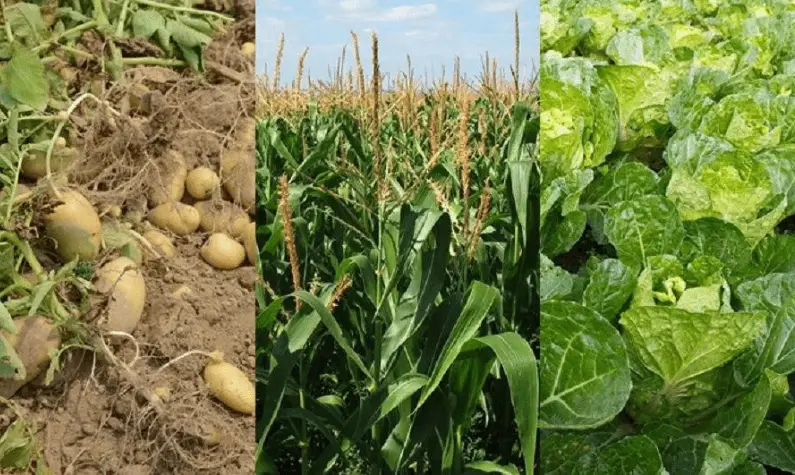What To Plant After Potatoes: Congratulations on your foresight about this topic. It makes you a real thoughtful cultivator for sure! Crop rotation is a secret gardening technique that has been practiced by mankind for thousands of years. Crop rotation is the practice of planting a different crop in a field after a crop has completed its growing season in the same field. If you want to cultivate potatoes in your yard this year, you can plant them and then plant cucumbers next year. Crop rotation is essential for a variety of reasons. When you rotate your crops, you can restore soil nutrients, break the life cycle of pests, and have a more varied harvest over several years. Crop rotation has a plethora of advantages. Crop rotation is essential for growing potatoes if you want a healthy harvest and a higher yield. Are there any further advantages to crop rotation? What should you plant in place of potatoes after they have been harvested?
Contents
- Why Should You Rotate Crops?
- Nutrient Retention
- Nitrogen Fixation
- Pest and Disease Control
- Greater Harvest Yearly
- When Should Potato Rotation Be Practiced?
- Diseased Potato
- Nutrient Deficiency
- What To Plant After Potatoes?
- What To Plant After Potatoes For More Yield?
- What To Plant After Potatoes For Retention Of Nutrients?
- Conclusion
- If my potatoes get blighted, what should I do?
- Is there anything that I should not do after growing potatoes?
- What crops should I not plant after potatoes?
- Root Vegetables
- Solanaceae Family Members
- Potato
Why Should You Rotate Crops?
Crop rotation is beneficial for a variety of reasons. These reasons are described further below.:
Nutrient Retention
Plants require a variety of nutrients to survive and thrive. The nutritional requirements of potatoes differ from those of other plants in several respects. If you continue to cultivate potatoes in a particular location regularly, the soil will quickly become depleted of the nutrients that potatoes require the most to thrive. By rotating potatoes with vegetables with different nutritional requirements, such as cabbage, the soil will have enough nutrients to support the growth of potatoes when they are planted again.
Nitrogen Fixation
Plants in the Fabaceae family, commonly known as legumes, can fix nitrogen in the soil (with the help of friendly bacteria). Planting legumes between potato crops will help restore nitrogen levels in the soil.
Pest and Disease Control
It is possible to contract a wide range of infections when growing potatoes. Following a harvest disaster (for example, sick potatoes), replanting them will result in the replanting of even more diseased potatoes. When you plant a completely different crop (from a different family), the number of bacteria, fungus, and other pests that infested your potatoes will decrease since these organisms will not be able to find an appropriate host for their reproduction.
Greater Harvest Yearly
If you plant potatoes in the spring, you will most likely be able to harvest them in the late summer or early fall. What exactly happens to the soil during the winter months is unknown. However, even though the primary goal of crop rotation is to plant a new crop for the entirety of the year, you can produce potatoes from May to September (depending on the kind of potato) and then plant something else for harvest in the late fall (or winter). Planting more crops will result in a higher yield in a single growing season.
Crop rotation is done for a variety of reasons by gardeners. After learning the fundamentals, why would you want to alternate your potatoes with other plants?
It should be noted that many gardeners who practice organic farming employ crop rotation (i.e., they use fewer inorganic fertilizers, pesticides, and herbicides). In biodegradability, an organic substance is any material generated from plants, animals, fungus, or microbial sources (i.e., living things) and is biodegradable. ‘Organic’ can also apply to gardening practices that do not entail the use of chemicals such as fertilizers, herbicides, and other such substances. Plants that are grown organically are healthier and produce fruits that are of a higher caliber.
When Should Potato Rotation Be Practiced?
Diseased Potato
If you pull up tubers that have been affected by a soil-borne illness, you should not plant potatoes in that soil for as least two or three years afterward. Make an effort to identify the disease and cultivate crops that are not susceptible to it.
Nutrient Deficiency
If you observe that your potato crops are deficient in a particular nutrient, you should replace them with a different vegetable in the same plot of land. Planting light feeders or legumes is an option. This article includes a list of crops that can be planted after potatoes to aid in retaining nutrients in the soil.
Now that you understand what crop rotation is, why it is essential to implement crop rotation, and when it is necessary to rotate potatoes, what vegetables can you put in their place after potatoes? Please continue reading.
What To Plant After Potatoes?
You should have a good cause for rotating crops before deciding on which vegetables to grow following potatoes. The plants you will grow using crop rotation to manage potato pests and disease are distinct from the plants you will produce if you are using crop rotation to help retain nutrients in the soil during the growing season. The following are lists of vegetables suitable for crop rotation for a variety of reasons.
What To Plant After Potatoes For More Yield?
Consider growing some plants that can withstand the fall season if your garden soil is healthy; your harvested potatoes are free of illness. There is still time to plant additional crops in your garden before the season ends (or early winter).
If you gathered your potatoes in May, you should consider planting the following:
- Melon
- Pepper
- Pumpkin
- Cucumber
- Sweet Potato
- Winter Squash
After harvesting potatoes in June, you may plant the following plants or crops:
- Okra
- Pepper
- Pumpkin
- Cucumber
- Winter Squash
- Cilantro
- Cowpeas
- Sweet corn
- Fall tomatoes
- Winter Squash
Lastly, you can buy and plant the following plants in July:
- Kale
- Onions
- Fall peas
- Green beans
- Winter squash
What To Plant After Potatoes For Retention Of Nutrients?
According to the USDA, light/medium-feeding crops are the best plants to seed to keep some nutrients in the soil. This type of crop rotation is recommended to last for more than a year because some of these crops prefer the spring or summer growing seasons. The following are examples of light/medium feeding crops:
- Dill
- Peas
- Fenugreek
- Parsnips
- Dolichos
- Soybeans
Did you notice that the majority of the veggies listed above are legumes? This is not a coincidence. Because legumes can create nitrogen on their own, they require less nitrogen from the soil to thrive (with the help of friendly bacteria). When legumes die and degrade, they add even more nitrogen to the soil, making it a more fertile environment.
Conclusion
Potatoes should not be grown in the same soil year after year for a long period. In order to preserve nutrients and control pests without the use of inorganic fertilizers and pesticides, it is recommended that you rotate crops in your garden. Your maincrop potatoes will be ready for harvest in a short period of time. Plan ahead for what to plant next, take the help from this article, and make your crops better than ever!
Frequently Asked Questions (FAQ)
If my potatoes get blighted, what should I do?
Remove them from consideration. Do not compost potato plants that have been infected with a disease.
Is there anything that I should not do after growing potatoes?
Eggplant, tomatoes, and peppers are examples of plants that should not be grown alongside or after potatoes. Potatoes do not grow well in the soil where they were planted or planted next to each other.
What crops should I not plant after potatoes?
The plants you should not plant just after potato are given below:
Root Vegetables
Planting other root crops after potatoes may be a recipe for catastrophe despite having different nutrient requirements and not closely related to potatoes. Bugs and other underground pests that feed on and infect the tubers of potatoes are attracted to them by their sweet flavor. The pests will enjoy munching on root crops such as beets, carrots, and turnips; if you plant them after potatoes, they will find them just as delicious as they did your potatoes. The pest problem may be worse than it was with your potato crop because the pests have had more time to proliferate in the soil.
Solanaceae Family Members
Potatoes are a member of the Solanaceae family of plants. Tomatoes, peppers, and eggplants are among the crops that belong to this group of crops. These plants are all subject to the same diseases and pests as one another because of their tight familial links. Even if your potatoes did not show signs of disease when they were harvested, the soil in which they were grown might still contain specific fungi that can wreak havoc on the roots of tomatoes over the subsequent growing season. Pepper and potato plants are related in that they have comparable nutrient requirements, and pepper plants cultivated in the same soil that was used for potato plants the previous year may suffer from nutritional deficiency or have a low yield.
Potato
An area of a garden bed that was utilized for potatoes one year should not be used for another crop of potatoes the following year. One issue with growing potatoes in the same bed year after year is that potatoes are heavy feeders, which makes them difficult to manage. Growing another crop of potatoes in the same potato bed as the previous year depletes the soil of nutrients, resulting in low yields or a need for fertilizer for the following year. Another issue is the presence of illness. If a disease affects the initial crop of potatoes in a bed, the next year’s crop in the same bed is likely to have a more severe case of the disease. The repeated cultivation of potatoes on the same plot of land was one of the primary reasons for the spread of blight that resulted in the Irish potato famine. If you continually plant their preferred meal in the same soil, potato-destroying pests in the soil become abundant, just like a disease does.




